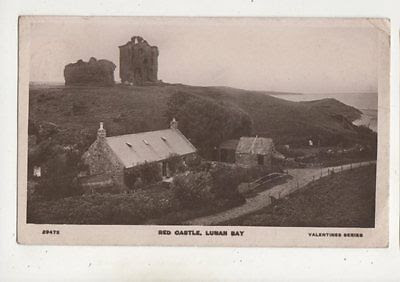A strange dream is one thing and an odd dream that manifests in waking life as reality is another. But the rarest, most amazing sub-category perhaps is that class of dream which promises a brilliant future and sometimes, somehow comes to pass.
Here is the tale of such an incident from Angus in the 18th century; this version contained in
Haunted Rooms, Elliott O'Donnell (1931), p. 25:
The first William Imrie of Lunan, fearing his father would force him to become a farmer, ran away from home. He slept, the first night, amid the ruins of Redcastle, and had a most vivid dream. He thought he went to London, married a rich woman, became owner of a fine house, and, on returning to Lunan, with his pockets well lined with money, was addressed by everyone as laird. Awaking with the feeling that the dream was no ordinary one, he tramped to the nearest port, and sailed thence to London. The dream came true. He married a woman with money, became proprietor of an hotel in Fountain Court, the Strand, where Angus lairds often met, and which was ultimately converted into the famous Judge and Jury Tavern, returned to Scotland a rich man, and bought an estate in Lunan. He died in 1798.
The book Around the Ancient City, published by D.H. Edwards in Brechin (1887) adds further details. Imrie was actually a native of Aberdeenshire and had been making his way south of foot when he entered Angus and had the fateful dream in the ruins of the venerable old castle. He returned to Scotland, rich of course, and settled in Lunan in 1759. The source quoted below, which relates the later inheritance of the estate, gives a different date of death for the fortunate Mr Imrie.
I will be on the look out for earlier versions of this intriguing tale. In the meantime, I wonder if it was something in the sepulchral atmosphere of Redcastle itself which sponsored his involuntary seership?
The Later Lairds of Lunan
William Imrie's children all died in infancy, and his wife only survived her removal to the mansion-house of Lunan for the short space of six weeks. He died in 1790, and was succeeded by Alexander Taylor-Imrie (greatgrandfather of the present proprietor), who married Agnes Simpson, a niece of William Imrie. Alexander Taylor-Imrie died on the 21st September 1813, and was succeeded by his second son, William. On the 24th of October 1846, William Taylor-Imrie executed a disposition and deed of entail of the lands of Lunan in favour of himself and certain heirs of tailzie; he died on the 11th March 1849, unmarried. The first heir of entail named in the deed after the entailer himself was his nephew, Lieutenant-Colonel and Brigadier James Blair, eldest son of his eldest sister, Elizabeth, who had married Captain James Blair, of the (8th) Forfar and Kincardine Militia. He never succeeded to the estate, having predeceased his uncle. When Captain Blair's regiment was quartered in Musselburgh, in 1806, the freedom of that burgh was presented to him on the 10th October of the same year.
Brigadier James Blair, who, as above mentioned, predeceased (1847) his uncle, married Charlotte Cecilia, seventh daughter of Brigadier-General Jacob Vanrenen. During the Nepaulese war in 1815, while carrying by assault the fortified heights and town of Almora, he was severely wounded by a bullet, which, however, struck two rupees which he had in his pocket. The extracted bullet, and the two coins which saved his life, are still treasured in the family. William Blair-Imrie, the second, but eldest surviving son of Brigadier James Blair, succeeded to the estate while a minor, in 1849, on the death of his granduncle, and assumed (according to the terms of the entail) the name and arms of Imrie.





No comments:
Post a Comment